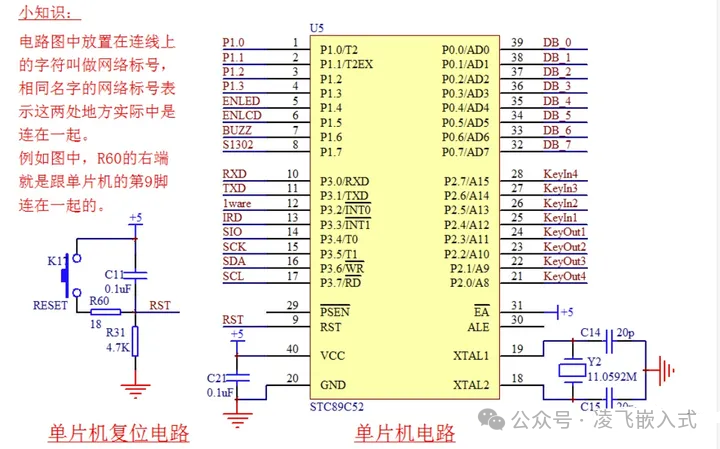1. Overview of Microcontroller Technology
1.1 Definition and Core Architecture A microcontroller is an integrated circuit that incorporates a central processing unit (CPU) with data processing capabilities, random access memory (RAM), read-only memory (ROM), various I/O ports, an interrupt system, timers/counters, and possibly additional circuits such as display drivers, pulse width modulation circuits, analog multiplexers, and A/D converters, all integrated into a single silicon chip to form a compact and complete computer system. A typical structure includes the following core units:
- • Central Processing Unit (CPU): The core that executes instructions and controls operations
- • Memory:
- • Flash Program Memory: Non-volatile memory that supports multiple erase cycles (e.g., STC89C52RC has 8KB built-in Flash)
- • RAM Data Memory: Volatile high-speed data cache (e.g., STC89C52RC has 512B built-in RAM)
- • Special Function Registers (SFR): Key interfaces for configuring microcontroller functions
- • Peripheral Interfaces: Including communication modules such as UART, SPI, I²C
- Minimum System

1.2 Technical Advantages and Application Scenarios
- • Low Power Consumption and High Integration: Typical power consumption is below 100mW, suitable for battery-powered scenarios
- • Real-time Control Capability: Hardware-level interrupt response (ns-level latency)
- • Mainstream Application Areas:
- • Industrial Control (PLC, Motor Drive)
- • IoT Terminals (Sensor Nodes, Smart Home)
- • Consumer Electronics (Home Appliance Control, Medical Devices)
2. What Can Microcontrollers Do?
From toy cars and electronic watches to spacecraft and robots, microcontrollers are ubiquitous in data acquisition, industrial control, and intelligent instruments and communication devices. Their main application areas include: (1) Application in Mechatronics. The integration of microcontrollers with traditional mechanical products simplifies structures and leads to intelligent control, transforming traditional products into the next generation of mechatronic products, which is the direction of mechanical industry development. (2) Application in Monitoring Systems. Microcontrollers in instruments and devices promote the development of digitalization, intelligence, multifunctionality, and integration in measurement instruments. The software programming technology of microcontrollers effectively addresses long-standing issues such as error correction and linearization in measurement instruments. (3) Application in Measurement and Control Systems. Microcontrollers can be used in various industrial control systems, adaptive control systems, and data acquisition systems. For example, they are used in boiler control, motor control, vehicle detection systems, automatic control of sluices, CNC machine tools, and military weaponry. (4) Application in Intelligent Interfaces. Computer systems, especially larger industrial measurement and control systems, use microcontrollers for interface control management, allowing parallel operation with the host to significantly improve system operation speed.
3. Recommended Microcontrollers for Beginners
For beginners, the 51 series microcontroller is recommended. There is a wealth of learning materials available, and they are easy to find online. The 51 series microcontroller has a significant market share and can be found in many products. Additionally, it serves as a foundation for learning high-end MCUs such as ARM, DSP, and FPGA.2.1 Recommended Model: STC89C52RC
- • Advantages:
- • Comprehensive development ecosystem (Keil C51/STC-ISP)
- • Compatible with the classic 8051 instruction set, low learning cost
- • Rich peripheral interfaces meet basic development needs
4. Typical Application Case: LED Control
- 4.1 LED Circuit Principle:

4.2 Software Development Process
- Setting Up the Development Environment:
- 1. Keil C51 v5.29 (supports STC series chips)
- 2. STC-ISP programming tool (USB to serial driver required)
- Core Code Implementation
#include <reg52.h> // Include register definitions#define LED P0_0 // Macro definition for simplificationvoid Delay(unsigned int t) { while(t--); // Precise delay control}void main() { while(1) { LED = 0; // Turn on LED Delay(50000); LED = 1; // Turn off LED Delay(50000); }}
- Debugging and Optimization:
- 1. Use a logic analyzer to verify timing
- 2. Add debounce algorithms to prevent false triggering
5. Advanced Learning Path
5.1 Directions for Skill Enhancement
- • Hardware Level:
- • Master PCB design specifications (Altium Designer)
- • Familiarize with power integrity analysis
- • Software Level:
- • Real-time operating systems (FreeRTOS porting)
- • Driver development (UART/SPI/I²C protocol stack)
Microcontroller technology, as the core carrier of smart hardware, has become an essential skill for modern engineers. Through systematic learning of hardware architecture, software development, and typical application cases, developers can quickly master the complete process from prototype design to mass production. It is recommended to tackle technical challenges progressively based on actual project needs, gradually building a comprehensive knowledge system of embedded systems.